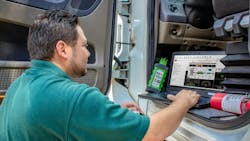Hunt for workflow efficiency starts with integrating diagnostic tools and data platforms
Key takeaways:
- Diagnostic software integrations can help shops streamline the flow of data from fleets to techs to platforms
- Having a singular place to access all of this information can increase technician efficiency
- But increased connectivity and complexity may push up diagnostic tool costs, which fleets will need to plan for as they work to improve these tools' ROI
Shops serious about growth and sustained success must constantly hunt down workflows to improve like a grizzly bear calorie-loading before a long hibernation, especially when their trusty fleet customers are starving due to the prolonged freight recession. You never know how long your last big month of revenue will have to last, so it's wise to be as efficient as possible with what you have.
You can start with low-hanging fruit, such as making sure your diagnostic tools and data are fully integrated with your shop management software, customer telematics, and other systems to enhance connectivity and create a seamless flow of data from the vehicle to the repair order. This has become easier as diagnostic tools have evolved (as we covered in-depth here).
For instance, Noregon's ShopPulse shop management platform connects diagnostics to broader shop management functions, including invoicing, parts, and customer relations. By linking data directly to work orders, ShopPulse reduces administrative friction while improving quoting accuracy and scheduling.
Kristy Coffman, director of the commercial vehicle group at Mitchell 1, said that pulling fault codes, labor times, and parts availability into the RO before the vehicle even enters the bay enables technicians to start repairs better prepared. Mitchell 1 has recently integrated the FinditParts catalog into its system, allowing shops to source parts directly through their diagnostic workflow.
“That’s something that has been in our automotive shop management system for about 20 years, but it is a new concept in the heavy-duty space,” Coffman said, explaining that the integration eliminates the need for multiple calls, saving time and ensuring a more accurate quote for the customer.
Having a single pane of glass to manage repairs without having to jump back and forth between systems also adds convenience. TEXA USA's Texa IDC6 software integrates with industry accounts, such as Motor TrueSpeed and AutoAuth, to give technicians instant access to service data or vehicle authentication software within the same operating system without the need for separate logins or applications, said Jimmy Singh, tech support lead at TEXA. The IDC6 software also embeds wiring diagrams so techs can access them quickly and without Wi-Fi when a shop’s internet connection is interrupted.
Mitchell 1 has added bookmarks to its system and component wire diagrams, allowing technicians to look up specific details on the diagrams and search for additional issues without losing their place.
Remote diagnostics are becoming increasingly common, enabling technicians to access vehicle data and perform diagnostics remotely, which can resolve issues without a service visit. “This approach may result in less downtime, lower maintenance costs, and greater operational efficiency for truck owners and fleets,” said Duane ‘Doc’ Watson, technical trainer at Bosch Mobility Aftermarket.
Integrating telematics and remote diagnostics is a must for any shop that wants to stay competitive, said Bruno Gattamorta, chief commercial officer for Cojali USA. “It fundamentally changes the relationship with customers by allowing for a more proactive, rather than reactive, service model,” he said.
Planning ahead
Dan Carrano, vice president of fleet maintenance at A. Duie Pyle, expects equipment to continue getting more complex as emissions controls, electric components, and safety technologies increase.
“Everything is becoming more computer-controlled. You have the mechanic doing the nuts-and-bolts things, but when it comes to computerized functions, you need the laptop,” he said.
That will increase the costs for shops, but Watson said they will see a return on investment. “While heavy-duty diagnostic tools require a higher initial investment due to modern truck complexity and ongoing software fees, they streamline repairs, minimize downtime, and boost efficiency, resulting in strong ROI for repair shops,” he said, adding that as more manufacturers enter the market, increased competition may lower aftermarket tool prices in the future.
To measure the ROI of a diagnostic tool, Hedman recommends shops benchmark performance and measure improvements against historical operations or industry standards.
“For example, compare how many work orders your shop completed in an average quarter before and after investing in the tool,” he said. “Has dwell time decreased? Has your average invoice increased due to a thorough diagnosis uncovering all vehicle issues? There are plenty of efficiencies that directly impact profitability that the right tool can unlock for a shop.”
